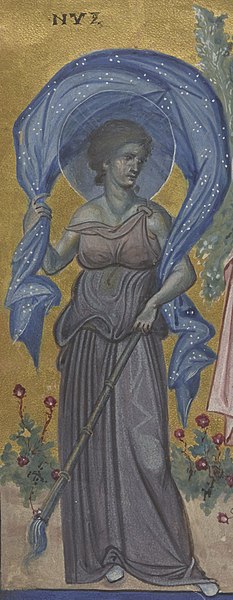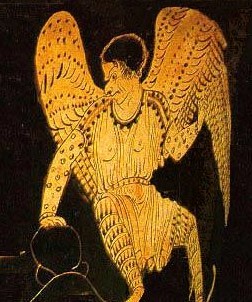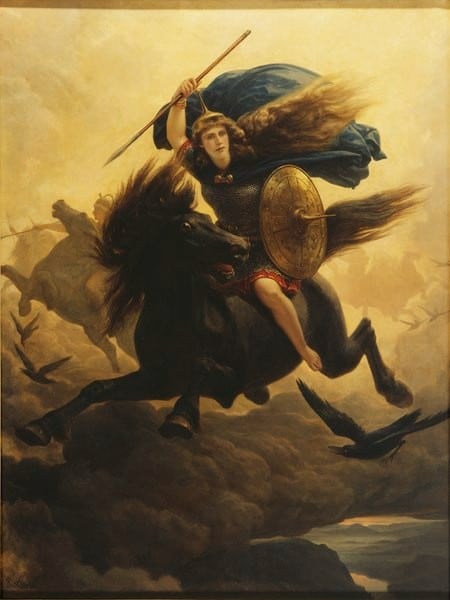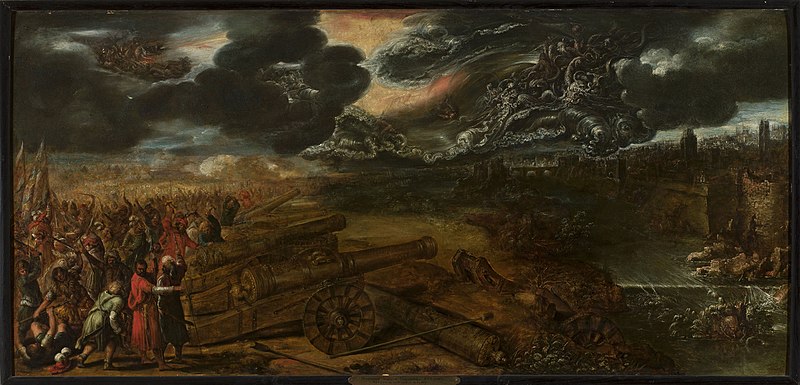In the vast and intricate tapestry of Greek mythology, the Keres hold a dark yet fascinating place. These personified spirits of violent death are often overshadowed by more celebrated gods and heroes, yet their role is crucial in understanding the ancient Greek’s perception of death and fate. The Keres, often depicted as dark-winged women, swooping down upon the battlefield to claim the souls of the fallen, are a grim reminder of the inevitable end that awaits all mortals.
Keres Key Facts
| Parents | Nyx (Night) |
| Partners | None |
| Siblings | Moirai, Thanatos, Hypnos and others. |
| Offspring | None |
| Other names | None |
| Roman name | Tenebrae |
| The Spirits of | Violent death |
| Symbols | Dark wings, claws |
Name and Etymology
The name “Keres” is deeply rooted in ancient Greek language and culture, embodying a sense of dread and inevitability. The etymology of “Keres” traces back to the ancient Greek word κήρ (kêr), which translates to “death” or “doom.” This term appears as a proper noun in both singular and plural forms as Κήρ and Κῆρες, respectively, to refer to divinities. The legendary poet Homer utilized the term Κῆρες in the phrase κήρες θανάτοιο, which translates to “Keres of death,” painting a vivid picture of these entities as harbingers of demise.
The linguistic journey of the word κήρ (kêr) extends beyond a mere label for the divine entities. It also encompasses meanings like “plague” or “disease” and, in prose, can denote a “blemish” or “defect.” The related verbs κεραΐζω or κείρω translate to “ravage” or “plunder,” further emphasizing the destructive nature associated with the term. In some instances within Homer’s works, the words κήρ and moira (fate) are used interchangeably, hinting at a shared essence of inevitable doom.
The older, perhaps more primal meaning of κήρ is believed to be “destruction of the dead.” Hesychius of Alexandria, a notable grammarian and lexicographer, associates the word with the verb κηραινειν, which translates to “decay.” This association paints a vivid, albeit grim, picture of the Keres’ role in the natural cycle of life and death.
The Roman counterpart of the Keres are known as the Tenebrae, translating to “darkness” or “shadows.” While the Roman name carries a different etymology, the essence of dark, inevitable fate remains a shared theme between the Greek and Roman interpretations of these entities.
Keres Origins
The lineage of the Keres traces back to Nyx, the primordial goddess of the night, a being even feared by Zeus, the king of gods. Born of Chaos, Nyx was a deity of such grandeur and dread that even the mighty Olympians shied away from her dark veil. The Keres, as offspring of Nyx, inherited a portion of this awe-inspiring dread, becoming entities that even the gods could not easily sway.

In the realm of Greek myth, the Keres are categorized as Daemones, spirits that personify abstract concepts or natural phenomena. Their role is to embody the violent death that awaits heroes and soldiers on the battlefield, a stark reminder of mortality’s fragile thread. The Keres, alongside their numerous siblings, form a grim ensemble that governs various aspects of life, death, and the human condition. Born from Nyx, the primordial goddess of the night, the Keres share their lineage with a host of other dark entities, each embodying different facets of existence and the human experience.
Keres Siblings
Nyx, though she lay with none, gave birth to a myriad of entities, each representing different aspects of life’s hardships and inevitabilities. Among them are Moros (Doom), Thanatos (Death), Hypnos (Sleep), and the tribe of Oneiroi (Dreams). The goddess also bore Momus (Blame), painful Oizys (Misery), and the Hesperides as well as the Moirai (Fates). The list extends to Nemesis (Revenge), Apate (Deceit), Philotes (Friendship), hateful Geras (Old Age), and hard-hearted Eris (Strife).
In the realm of Greek myth, the Keres are categorized as Daemones, spirits that personify abstract concepts or natural phenomena. Their role is to embody the violent death that awaits heroes and soldiers on the battlefield, a stark reminder of mortality’s fragile thread. The Keres, alongside many of their siblings, personifies all the forces that govern the end of mortal life. They were each playing a crucial part in the ancient Greeks understanding of death and destiny.
Keres Relationships and Offspring
The Keres are unique in that they don’t engage in romantic entanglements or form partnerships, unlike many other figures in Greek mythology. Their singular focus is on fulfilling their grim duty, leaving no room for love or relationships.
Similarly, the Keres have no known offspring. Their existence is solely dedicated to their duty, devoid of personal desires or familial bonds. This lack of offspring or familial connections outside of their lineage from Nyx further emphasizes their detached, inexorable nature.
Depiction And Characteristics
The Keres are often depicted as dark-winged women, sometimes with the visage of a bird of prey, swooping down upon the souls of the fallen with a chilling, detached demeanor.

Their appearance is a stark reminder of their grim duty, with dark wings that blot out the sun as they descend upon the battlefield. The Keres are often shown with claws or other talon-like appendages, ready to snatch the souls of those who meet a violent end. Their visage is neither cruel nor compassionate; it’s the cold, unyielding face of death, devoid of emotion or mercy.
Symbolism
The symbols associated with the Keres are few but powerful. Their dark wings symbolize the swift and inevitable nature of death, while their claws represent the unyielding grip of fate. These symbols are not adorned or glorified; they are stark, straightforward representations of the Keres’ grim duty. The association of dark wings with the Keres is a powerful symbol of their swift, inexorable nature.
Keres Personality
The personality of the Keres is as cold and unyielding as their appearance. They are not swayed by pleas or offerings, nor do they revel in their grim task. They are the personification of violent death, devoid of personal desires or emotions. Their actions are not driven by malice or pleasure, but by the inexorable call of fate, a duty they fulfill without hesitation or remorse.
The ancient Greeks viewed the Keres with a mix of fear and respect. They were not entities to be appeased or bargained with; they were forces of nature to be acknowledged and feared. The Keres’ personality reflects the ancient Greeks understanding of death as a natural, inevitable part of life, a fate that awaits all mortals, regardless of valor or virtue.
Roles And Responsibilities
The primary role of the Keres is to claim the souls of those who meet a violent end, a duty they fulfill with a chilling efficiency. They are not swayed by pleas or offerings, nor do they revel in their grim task. They are the personification of violent death, a role they embody with a cold, unyielding demeanor.
The ancient Greeks believed that the Keres could not be swayed or deterred from their duty. Their power over death was absolute, a fact reflected in the chilling efficiency with which they claimed the souls of the fallen. The Keres’ powers are not flashy or flamboyant; they are grim, unyielding, a stark reminder of the inevitable end that awaits all mortals.
The responsibilities of the Keres extend beyond the battlefield. They are a reminder of the inevitable end that awaits all mortals, a reminder that death can come swiftly and without warning. The Keres’ role in Greek mythology is a reflection of the ancient Greeks understanding and acceptance of death as a natural, inevitable part of life.
Keres vs. Norse Valkyries
The Keres and the Valkyries are fascinating embodiments of death from Greek and Norse mythologies respectively. Though they hail from different cultural landscapes, they share the common thread of being harbingers of death on the battlefield. However, their roles, characteristics, and attitudes towards them vary significantly.

Role and Function
The Keres are depicted as dark spirits of violent death, swooping down on battlefields to claim the souls of the fallen. They are agents of fate, unyielding in their duty to escort the souls to the underworld. Their presence is a grim reminder of the inevitable end awaiting warriors.
On the other hand, the Valkyries are divine maidens serving Odin, the Allfather in Norse mythology. Their primary role is to select those who may die and those who may live in battles. The chosen ones, known as the Einherjar, are taken to Valhalla, where they prepare for Ragnarok, the end of the world in Norse belief. Unlike the Keres, the Valkyries are not merely harbingers of death but selectors of the worthy.
Appearance and Perception
The Keres are often described as frightful and loathsome creatures, with an appearance as dark as the fate they represent. They are feared and avoided, embodying the terror associated with death.
Contrastingly, the Valkyries are depicted as beautiful, strong, and valiant maidens riding through the sky on horses or flying with swan wings. They are revered and respected, embodying the honor and glory of dying a heroic death.
Interaction with Mortals
The Keres have a one-dimensional interaction with mortals, which is to claim their lives. There’s no indication of choice or preference in whom they claim; death through the Keres is depicted as an indiscriminate act.
The Valkyries, however, interact more complexly with mortals. They choose the bravest of the fallen to accompany them to Valhalla, indicating a level of discernment and interaction that goes beyond the mere act of claiming lives.
Cultural Significance
The portrayal of the Keres and Valkyries reflects the broader cultural attitudes towards death and honor in ancient Greece and Norse society. The feared Keres underscore the often grim Greek view of death, while the revered Valkyries reflect the Norse valorization of heroic death in battle.
Myths about Keres
The myths surrounding the Keres are as chilling as the entities themselves. They are often seen as harbingers of death, swooping down upon the battlefield to claim the souls of the fallen.
The Battle of Troy

One of the most notable mentions of the Keres is during the epic battle of Troy, where they are described as swooping down upon the battlefield, claiming the souls of the fallen with a chilling efficiency. The imagery of the Keres descending upon the battlefield is a stark reminder of the fragile thread of life that hangs in the balance during times of war and strife.
In Homer’s Iliad, the Keres are frequently mentioned, embodying the inevitable death that looms over the warriors on the battlefield. Their presence is a constant reminder of the fragile boundary between life and death, a boundary that could be crossed at any moment in the heat of battle. The phrase “Keres of death” used by Homer encapsulates the dread and inevitability associated with these entities. The Greeks perceived them as relentless forces of nature, unyielding in their duty to claim the souls of the fallen.
The Keres’ role in the battle of Troy is not one of malice or cruelty, but of duty. They are agents of fate, fulfilling their grim task with a cold, unyielding demeanor. The ancient Greeks viewed the Keres with a mix of fear and respect, acknowledging their role in the grand scheme of life and death.
The Tale of Achilles
The tale of Achilles, the mighty Greek hero, also intertwines with the lore of the Keres. As foretold by prophecy, Achilles was destined to die young. The Keres, as agents of fate, played a crucial role in fulfilling this prophecy. Understood as a grim reminder of the inexorable nature of fate.
In the Iliad, the Keres are depicted as being ever-present on the battlefield. Their dark essence a constant shadow over the warriors, including Achilles. The narrative describes how even the mightiest of heroes could not escape their clutches when fate deemed it time. The imagery of the Keres descending upon the battlefield to claim the soul of Achilles is a haunting one.
The tale of Achilles and the Keres is a powerful narrative. Underscoring the ancient Greek’s understanding and acceptance of death as a natural, inevitable part of life. It’s a narrative that resonates across time, a reminder of the inexorable nature of fate and the fragile thread of life that hangs in the balance.
Medea’s Summoning of the Keres
In the epic journey of Jason and the Argonauts, as narrated in Apollonius Rhodius’ “Argonautica,” the companions face a formidable adversary in Talos, the bronze guardian of Crete. As they approach the island, Talos threatens to thwart their quest. Amidst the looming danger, Medea, a powerful sorceress and a companion to Jason, resorts to invoking the dreaded Keres to overcome this colossal foe.
With a blend of incantations and a steely resolve, Medea calls upon the Keres. Summoning the harbingers of death from the underworld. Chanting her incantations, the malevolent spirits heed her call, bridging the chasm between the realms of the living and dead. Medea’s dark incantations then bewitch Talos. Finally, piercing through his bronze frame with a force of malevolence that even his mighty form could not withstand.
As fate would have it, Talos grazes his ankle on a sharp rock, causing the ichor, his life essence, to spill out like molten lead. Drained of his strength, the once mighty guardian crashes down, defeated by the unseen, dark forces summoned by Medea. This tale encapsulates the ancient Greek belief in the power of magic and the inexorable touch of death, showcasing the lengths to which Medea and the Argonauts were pushed to ensure the success of their epic quest.
Representations In Art
The Keres have been depicted in various forms of ancient Greek art, often seen swooping down upon the battlefield with their dark wings spread wide. These depictions are a stark reminder of their grim duty, a chilling portrayal of the inevitable end that awaits all mortals.
One notable representation is found in ancient Greek pottery. There Keres are depicted as dark-winged women, swooping down upon the souls of the fallen with a chilling, detached demeanor. These depictions are not adorned or glorified; they are stark, straightforward representations of the Keres’ grim duty.
The Keres in ancient Greek art are a reminder of the fragile thread of life that hangs in the balance. Especially is this true during times of war and strife. It’s a reminder that death can come swiftly and without warning, a reminder of the inexorable nature of fate and the inevitable end that awaits all mortals.
Mentions in Ancient Texts
The Keres, as personifications of violent death, have found their way into various ancient texts. Each portrayal is shedding light on the Greek understanding of death and fate.
Homer’s Iliad
Homer, believed to have lived around the 8th century BC, vividly describes the Keres in his epic, the Iliad. Through the narrative, Homer portrays the Keres as relentless entities, embodying the inevitable death on the battlefield. One notable quote from the Iliad goes like this. “The father [Zeus] balanced his golden scales, and in them he set two fateful portions of Ker (Death)…”
Apollonius Rhodius’ Argonautica
Apollonius Rhodius, a scholar of the 3rd century BC, delves into the lore of the Keres in his work, Argonautica. In the tale of Medea she summones them to defeat the bronze giant Talo. Apollonius uses that narrative to explore the dark arts and the inexorable touch of death. He writes, “Then, with incantations, she invoked the Keres (Spirits of Death), the swift hounds of Hades who feed on souls and haunt the lower air to pounce on living men.”
Hesiod’s Theogony
Hesiod, believed to have lived around the 7th century BC, mentions the Keres in his work, Theogony. In it Hesiod outlines the genealogy of the Greek gods and other divine entities, including the Keres. Furthermore he is offering a glimpse into the ancient Greek cosmology and the place of the Keres within it.
Frequently Asked Questions
The Keres are known as the personified spirits of violent death in Greek mythology. They are often depicted as dark-winged women, swooping down upon the battlefield to claim the souls of the fallen.
The Keres are the offspring of Nyx, the primordial goddess of the night.
Yes, the Keres are mentioned in the epic battle of Troy and the tale of Achilles. There they are seen as harbingers of death.
The Keres are often depicted as dark-winged women, sometimes with the visage of a bird of prey.
The primary symbols associated with the Keres are their dark wings and claws. They represent their grim duty of claiming the souls of those who meet a violent end.
The ancient Greeks viewed the Keres with a mix of fear and respect. Acknowledging their role as agents of fate.
